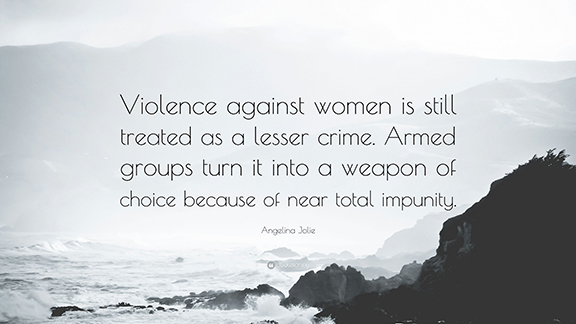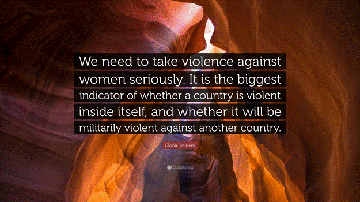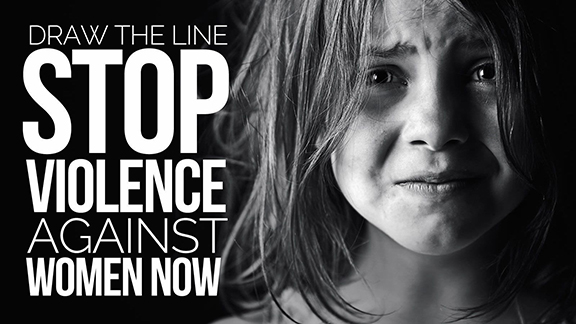By: ZUNAIRA ZAHID
It’s been called the “silent epidemic” because it’s so often hidden behind closed doors. But the truth is that violence against women is a real problem in our society.




Violence against women is any act or threat of physical, sexual, or psychological violence directed against women by men. It can take many forms, from domestic violence and sexual assault to trafficking and sexual exploitation. It occurs in all parts of the world and affects women of all ages, social classes, religions, and ethnicities.(1)
The problem of violence against women is all too often ignored. It’s a global pandemic, yet it remains one of the most underreported crimes. The World Health Organization estimates that one in three women will experience physical or sexual violence. And yet, the silence around this issue is deafening.
“We often think of violence only in inner cities or poor neighbourhoods. But the truth is that violence can happen anywhere, to anyone, at any time. It knows no boundaries.”
Physical violence is a serious problem that can have devastating consequences. It includes slaps, shoves, punches, kicks, twisting arms, choking, and being burnt or stabbed. It can also include slaps, shoves, hits, puns, pushes, or being thrown downstairs or across the room. As a result, women of physical violence often suffer from physical injuries, psychological trauma, and even death. In addition to the immediate consequences, physical violence can also lead to long-term problems such as post-traumatic stress disorder, anxiety, and depression.
Psychological and emotional abuse is another form of violence that can be just as damaging as physical abuse. It can include various behaviours such as isolation from family and friends, continual humiliation, threats against children, or being threatened with injury or death. This abuse can be far-reaching effects, including physical health problems, mental health issues, substance abuse, and even suicide.
Family violence is yet another form of violence against women. It includes any abuse that takes place within a family or intimate relationship. It includes the same behaviours as domestic violence but can also include forced marriage, dowry-related violence, and honour killings. Family violence is a serious problem that can have devastating consequences for women and their families.
And it does not just stop there; financial or economic abuse is another common form of violence against women. It includes controlling access to money, preventing a partner from working or using their income to meet the abuser’s needs while leaving the woman without enough money to live. This abuse can seriously impact a woman’s ability to support herself and her family.
And one of the most common but often overlooked forms of violence against women is sexual violence. It includes any sexual activity that is forced or coerced. This can include rape, attempted rape, child sexual abuse, and intimate partner sexual violence.
Sexual violence often leaves women feeling scared, humiliated, and powerless. In addition, it can lead to physical injuries, sexually transmitted infections, unwanted pregnancies, and mental health problems like post-traumatic stress disorder.
“No matter what type of violence, the effects are always devastating.”
And if you scroll through news headlines or the internet, social media, you’ll see that violence against women is happening all too often. (2)
- A third of women in the U.S. will be raped, physically abused, or stalked by an intimate partner at some point in their lives. (source)
- Worldwide, nearly a third of women (15-49 years) in relationships report experiencing physical and sexual violence from their intimate partners. (source)
- When a gun is present in the house, women are six times more likely to be killed in domestic violence homicides. (source)
- It is estimated that intimate partners commit 38% of all women’s murders worldwide. (source)
- The proportion of American Indian/Alaska Native women who an intimate partner has violated in their lifetime is nearly half (47.5%), 45.1% of non-Hispanic Black women, 37.3% of non-Hispanic White women, 34.4% of Hispanic women, and 18.3% of Asian-Pacific Islander women. (source)
- There is a 40% greater risk of intimate partner violence among women with disabilities, especially severe violence. (source)
- 53% of battered women blame themselves for the violence caused by their perpetrators. (source)
- Homeless women have experienced domestic violence in approximately 63% of their lives. (source)
- Approximately one in five female high school students have experienced physical or sexual abuse from a dating partner. (source)
Factors Associated With Increased Risk of Violence Against Women:
Research has shown that unequal distribution of resources and power between men and women creates an environment ripe for violence. This could be due to poverty, social norms that support male power and control, or weak legal systems that fail to protect women’s rights. Various community norms operate in societies worldwide that privilege or ascribe higher status to men and lower status to women.
One of the most important is the norm of male breadwinning, which places a high value on men’s paid employment and few accolades on women’s unpaid domestic labour. Others buttress this norm, such as the idea that women are naturally more nurturing and, therefore, better suited for caregiving roles. Men are more physically strong and, therefore, better suited for manual labor. Together, these norms create a set of expectations about gender roles that limit women’s access to paid employment and contribute to low levels of gender equality.
There is no one answer to why some men engage in harmful masculine behaviours. However, several factors can contribute to these behaviours. For example, some men may grow up in environments where violence is seen as an acceptable way to resolve conflict. Others may feel pressure to conform to traditional ideas about being a man, including having multiple sexual partners. Additionally, some men may use harmful behaviours to assert their power and dominance over others. Also, men can’t control their anger or sexual urges; they have a sense of entitlement; they were exposed to violence as children, witnessed their mother being abused, or had mental health issues.
“We need to end the silence around violence against women and do it now.”
Witnessing family violence as a child can also increase the likelihood of perpetrating violence against a partner as an adult. For example, boys who grow up in homes where they witness their fathers being violent are much more likely to be violent with their partners when they become adults. In addition, children who witness family violence are more likely to have mental health problems, struggle in school, and use drugs and alcohol. They’re also more likely to be violent themselves as adults.
Harmful use of alcohol is also a major factor in intimate partner violence. Alcohol is involved in about half of all domestic violence cases. Alcohol abuse can make it more likely for someone to commit acts of violence and make it more difficult for women to defend themselves or escape abusive situations. Furthermore, Marital discord and dissatisfaction are often precursors to partner violence. When couples cannot communicate effectively or when there is a lack of satisfaction in the relationship, it can lead to frustration and anger that may be expressed through violence.
Health Consequences:
The health consequences of violence against women are far-reaching and serious. Women who experience violence are more likely to have various chronic health problems, including mental health issues, gastrointestinal disorders, headaches, and sexually transmitted infections. Additionally, pregnant women who experience violence are more likely to have miscarriages, stillbirths, and low-birth-weight babies. Women who experience violence also often miss work or have difficulty concentrating at work, which can lead to job loss or decreased productivity.
- As a result of intimate partner violence, 42% of women report having been injured. (3)
- Based on WHO’s 2013 study on violence against women, 1.5 times as many women who have been physically or sexually abused as those who have not experienced partner violence had a sexually transmitted infection and, in some regions, HIV.
(3) - Intimate partner violence in pregnancy raises the risk of miscarriage, stillbirth, pre-term delivery, and low-birth-weight newborns. Women who had experienced intimate partner violence were 16% more likely to miscarry and 41% more likely to give birth prematurely, according to a 2013 study. (3)
There are also long-term mental health consequences of violence against women. Women who experience violence are more likely to suffer depression, anxiety, sleep disorders, and eating disorders. They’re also more likely to have suicidal thoughts and attempt suicide. In addition, children who witness or experience violence in the home are more likely to have mental health problems than adults.
Prevention and Response:
Many things can be done to prevent violence against women. First, it’s important to challenge the myths and stereotypes perpetuating violence. We must teach young people—boys and girls—about healthy relationships, respect, and equality. It’s also essential to support women of violence and let them know they’re not alone. This can be done through schools, parents, community groups, and the media.
“We cannot allow this violence to continue. We need to stand up and say enough is enough.”
Support services can also make a big difference for women of violence. These services can provide safety, shelter, legal assistance, counselling, and other forms of help. Laws and policies that protect women’s rights and hold abusers accountable can help to prevent violence against women. These laws should be based on international human rights standards, and they should be enforced. Community support systems that promote non-violent behaviour can also help to prevent violence against women. These systems include neighbourhood watch groups, community patrols, and hotlines.
In 2019, WHO and 12 other UN and bilateral agencies published the RESPECT women framework for preventing violence against women. Each letter stands for a different prevention strategy:
R – Relationship skills strengthening
E – Empowerment of women
S – Services ensured
P – Poverty reduced
E – Enabling environments (schools, workplaces, public spaces) created
C – Child and adolescent abuse prevented
T – Transformed attitudes, beliefs, and norms
One of the key goals of RESPECT is to highlight the fact that successful interventions are those that prioritize the safety of women. This includes interventions that challenge unequal gender power relationships, are participatory, address multiple risk factors through combined programming, and that start early in the life course. By working to promote these types of interventions, RESPECT hopes to create a world where all women can live safely and without fear of violence.
No one should be a victim of a crime. However, working together can help prevent violence against women and make our world safer for everyone. If you’re in an abusive relationship, it’s important to get help. Several national and international hotlines can help you find resources in your area. You can also contact your local police department or social services agency. Remember, no one deserves to be abused—no matter what.
It is important to remember that not all men are violent. In fact, most men are not. But we need to do more to engage men in the movement to end violence against women. We must challenge the harmful masculine norms and beliefs contributing to this violence. We need to support men who are violence survivors, and we need to engage men as allies in the fight to end this epidemic.
“We can all play a role in preventing violence against women. By working together, we can make our world a safer place for everyone.”
Bottom Line:
Ending violence against women starts with every one of us. We can raise our voices in protest, donate to organizations that work to end violence and be there for the friends and loved ones who have experienced it. We can all play a role in preventing it by working together to challenge the harmful stereotypes and norms that perpetuate it. We need to engage men as allies in this fight, and we need to support survivors. Only then can we hope to create a world where everyone can live safely and without fear.
If you or someone you know is a victim of violence, resources are available to help. Please don’t hesitate to reach out for help if you need it. Together, we can create a world where violence against women is no longer tolerated and survivors are supported. Thank you for reading this post and helping to spread awareness about this important issue!!!
References and Citations:
(1) United Nations. Declaration on the elimination of violence against women. New York: UN, 1993.
(2) Violence against women Prevalence Estimates, 2018. Global, regional, and national prevalence estimates for intimate partner violence against women and global and regional prevalence estimates for non-partner sexual violence against women. WHO: Geneva, 2021
(3) WHO, LSHTM, SAMRC. Global and regional estimates of violence against women: prevalence and health impacts of intimate partner violence and non-partner sexual violence. WHO: Geneva, 2013.
(4) Black, M.C., Basile, K.C., Breiding, M.J., Smith, S.G., Walters, M.L., Merrick, M.T., Chen, J., & Stevens, M.R. (2011). The National Intimate Partner and Sexual Violence Survey (NISVS): 2010 Summary Report. Atlanta, GA: Centers for Disease Control and Prevention, National Center for Injury Prevention and Control.
5) Brownridge, D.A. (2006). Partner violence against women with disabilities: Prevalence, risk, and explanations. Violence Against Women, 12(9), 805.
6) Family Violence Prevention Fund. (no date). Intimate partner violence and healthy people 2010 fact sheet. San Francisco, CA: Author. Retrieved October 18, 2012 from http://www.endabuse.org/userfiles/file/Children_and_Families/ipv.pdf (PDF, 124KB)
7) Silverman, J. G., Raj, A., & Clements, K. (2004). Dating violence and associated sexual risk and pregnancy among adolescent girls in the United States. Pediatrics, 114, 220-225. Retrieved October 19, 2012 from http://www.hawaii.edu/hivandaids/Dating_Violence_and_Assoc_Sexual_Risk_and_Preg_Among_Girls_US.pdf (PDF, 350KB)
8)Violence Policy Center. (2006, May). American roulette: Murder-suicide in the United States. Washington, D.C.: Author. Retrieved October 18, 2012 from http://www.vpc.org/studies/amroul2006.pdf. (PDF, 275KB)

